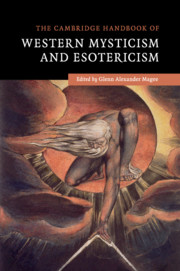Book contents
- Frontmatter
- Dedication
- Contents
- Acknowledgments
- Editor's Introduction
- List of contributors
- I ANTIQUITY
- II THE MIDDLE AGES
- III THE RENAISSANCE AND EARLY MODERNITY
- IV THE NINETEENTH CENTURY AND BEYOND
- 20 Spiritualism
- 21 H. P. Blavatsky and Theosophy
- 22 Rudolf Steiner and Anthroposophy
- 23 The Golden Dawn and the O.T.O.
- 24 G. I. Gurdjieff and the Fourth Way
- 25 C. G. Jung and Jungianism
- 26 René Guénon and Traditionalism
- 27 Via Negativa in the Twentieth Century
- 28 Contemporary Paganism
- 29 The New Age
- V COMMON THREADS
- Suggestions for Further Reading
- Index
- References
27 - Via Negativa in the Twentieth Century
from IV - THE NINETEENTH CENTURY AND BEYOND
Published online by Cambridge University Press: 05 May 2016
- Frontmatter
- Dedication
- Contents
- Acknowledgments
- Editor's Introduction
- List of contributors
- I ANTIQUITY
- II THE MIDDLE AGES
- III THE RENAISSANCE AND EARLY MODERNITY
- IV THE NINETEENTH CENTURY AND BEYOND
- 20 Spiritualism
- 21 H. P. Blavatsky and Theosophy
- 22 Rudolf Steiner and Anthroposophy
- 23 The Golden Dawn and the O.T.O.
- 24 G. I. Gurdjieff and the Fourth Way
- 25 C. G. Jung and Jungianism
- 26 René Guénon and Traditionalism
- 27 Via Negativa in the Twentieth Century
- 28 Contemporary Paganism
- 29 The New Age
- V COMMON THREADS
- Suggestions for Further Reading
- Index
- References
Summary
Introduction
The via negativa – or mysticism proceeding by way of negation – has a very long history in Christianity. We find it very early, in the work of Basilides, then again, pivotally, in the works of Dionyius the Areopagite, in Eriugena, and again in the high medieval period in Meister Eckhart, in Tauler and in anonymous works such as The Cloud of Unknowing. One even finds the via negativa hinted at in the works of Jacob Boehme, in particular in his terms Nichts, or the Divine Nothing beyond all that exists, and Ungrund, or the Not-ground as the means by which being-time comes into existence. One also sees this kind of via negativa terminology in the works of English theosophers, notably, John Pordage (1608–1681), who used the word “Chaos” to describe the transcendent plenitude out of which existence emerges.
But by the early modern period, exponents of the via negativa for the most part seem to have disappeared. Most of what has come to be termed “Western esotericism” is chiefly occupied with cosmological concerns – alchemical, magical, or related currents predominate. By the eighteenth and nineteenth centuries, one can find almost no exemplars of the via negativa, and even in the twentieth century, instances are few and far between. In fact, the absence of via negativa from theology or religious philosophy during this period is quite noteworthy. It is only in the mid-twentieth century, in part due to the influx of Asian religious traditions into the West, that we find the via negativa beginning to reappear. The via negativa is esoteric in a functional sense – that is, its adherents focus on absolute transcendence, which functionally generates an insider/outsider dynamic.
What Is the Via negativa?
Already by the second century, Basilides, the earliest of the Alexandrian Gnostics (ca. 120 CE), and said to be a disciple of St. Matthias and of Glaucias (a disciple of St. Peter), taught a negative mysticism that is quite similar to the central Buddhist work, the Prajnaparamita sutras. Both reject the ultimate value of any analogy in understanding the nature of direct spiritual knowledge: It is not like this, or like that.
- Type
- Chapter
- Information
- The Cambridge Handbook of Western Mysticism and Esotericism , pp. 322 - 333Publisher: Cambridge University PressPrint publication year: 2016



